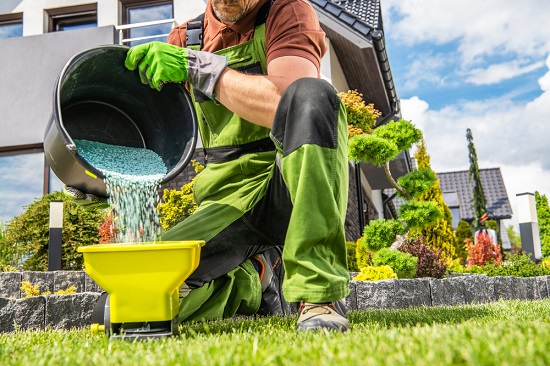
It is not easy to grow grass that will create a green, uniform lawn. Sod and grass seed both require large amounts of nutrients. Even the best soils may not have enough nutrients to sustain turf grass. This is especially true when you start a new lawn where one already exists. It doesn’t matter if you use seed or sod; knowing which fertilizers to use and when is key when it comes to proper lawn care.
Lawn Care Tips: Fertilizing New Lawns
Why Fertilize
Turf grasses require high levels of nutrients to sustain strong growth. Many lawns are started in soil that is too compacted or damaged to be fertile. Very few soils contain the nitrogen required for grass growth.
Sowing seed or sod in soil that lacks primary nutrients will result in a patchy lawn susceptible to insect invasion and weed growth. Your problems can be exacerbated by erosion and runoff. These problems can be avoided by starting with the best fertilizer possible for a new lawn. This will help to protect your turf from mowing and normal wear. No matter where you intend to add a lawn, it is important that the fertilizer be applied correctly in order for the environment to grow well.
It is worth spending the money and time to test your soil before you do anything else. Knowing the exact nutrients in your soil before you start can help you choose the best fertilizer. You may need one depending on where you live.
What is Starter Fertilizer?
Starter fertilizers are often labelled with “starter.” You might also see “turf builder” in the description. These products may contain higher levels of nutrients for a new lawn and may also have quick-release nitrogen to promote rapid growth. The soil condition will determine the formula and amount of fertilizer to use. It is helpful to have the soil test results in hand to eliminate any guesswork in your lawn care in Conway SC.
How to Use Starter Fertilizer
For a new lawn, choose a granular starter. Premixed ready-to-spray products are also available. These products can be used for problem areas. However, they are not cost-effective for large areas.
Starters can be applied before or after planting. Both are efficient and have their advantages, so the homeowner has to make the choice. Water heavily if you add starter after planting. This method allows you to water the plant while the fertilizer is being added. This saves time and eliminates a few steps.
When is it best to feed a new lawn?
Once the seed has germinated, or if the sod has rooted in, it is a good idea to apply a second dose of starter fertilizer. Test the grass by gently tugging at it. If the grass doesn’t move, it is establishing roots. A newly seeded lawn will require slightly more nutrients than a lawn that has been sodded.
When to Use Regular Fertilizer
Once the starter has been applied, your lawn can be fed with regular fertilizer. This will depend on your soil type, climate, and grass type. The amount of time and effort that you have available for lawn maintenance will determine how often fertilizer is applied. Some lawn care specialists recommend fertilizing three times a year in the spring, mid-summer and fall. Others recommend fertilizing your lawn once a year in the spring, mid-summer and fall to maintain a healthy lawn.
Call Conway Lawn Care Service now if you need expert help in maintaining your lawn.
Conway Lawn Care Service
Conway, SC 29526
843-353-2259
http://conwaylawncareservices.com/
No comments:
Post a Comment